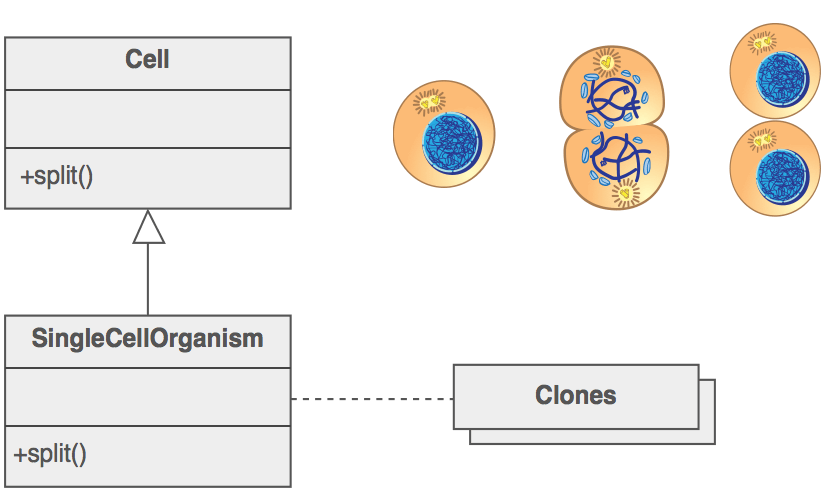Download the working example demo code in java from my GIT repository -https://github.com/premaseem/designPatterns/tree/4bb9beca7bab5b5e71d02b76e4f1ad48fce4aca6/ZipDownloadableProjects
Code Example
The Prototype pattern specifies the kind of objects to create using a prototypical instance. Cell is the abstract class with different subclasses like singleCell Organism, amoeba, bacteria etc. For each sub class a breeder object is created before hand and registered in SpecimenCache.java class. Now whenever client program wants to breed or culture a particular organism say amobea they will fetch it from cache and invoke split/clone method which will provide replicated organism with same state property. Download the example code and have fun.
Image may be NSFW.
Clik here to view.
When creating an object is time consuming and a costly affair and you already have a most similar object instance in hand, then you go for prototype pattern. Instead of going through a time consuming process to create a complex object, just copy the existing similar object and modify it according to your needs. Clone the existing instance in hand and then make the required update to the cloned instance so that you will get the object you need. Other way is, tweak the cloning method itself to suit your new object creation need.
Intent
Specify the kinds of objects to create using a prototypical instance, and create new objects by copying this prototype.
- Co-opt one instance of a class for use as a breeder of all future instances.
- The
newoperator considered harmful.
Problem
Application “hard wires” the class of object to create in each “new” expression.
Discussion
Declare an abstract base class that specifies a pure virtual “clone” method, and, maintains a dictionary of all “cloneable” concrete derived classes. Any class that needs a “polymorphic constructor” capability: derives itself from the abstract base class, registers its prototypical instance, and implements the clone() operation.
The client then, instead of writing code that invokes the “new” operator on a hard-wired class name, calls a “clone” operation on the abstract base class, supplying a string or enumerated data type that designates the particular concrete derived class desired.
Image may be NSFW.
Clik here to view.
Check list
Add a clone() method to the existing “product” hierarchy.
- Design a “registry” that maintains a cache of prototypical objects. The registry could be encapsulated in a new
Factoryclass, or in the base class of the “product” hierarchy. - Design a factory method that: may (or may not) accept arguments, finds the correct prototype object, calls
clone()on that object, and returns the result. - The client replaces all references to the
newoperator with calls to the factory method.
Rules of thumb
- Prototype co-opts one instance of a class for use as a breeder of all future instances.
- Prototypes are useful when object initialization is expensive, and you anticipate few variations on the initialization parameters. In this context, Prototype can avoid expensive “creation from scratch”, and support cheap cloning of a pre-initialized prototype.
- Factory Method: creation through inheritance. Protoype: creation through delegation.
- Often, designs start out using Factory Method (less complicated, more customizable, subclasses proliferate) and evolve toward Abstract Factory, Protoype, or Builder (more flexible, more complex) as the designer discovers where more flexibility is needed.
- Prototype doesn’t require subclassing, but it does require an “initialize” operation. Factory Method requires subclassing, but doesn’t require Initialize.
- Designs that make heavy use of the Composite and Decorator patterns often can benefit from Prototype as well.
Filed under: Creational patterns, Design Patterns Tagged: cloning, design pattern, Java, java tip, javatip Image may be NSFW.
Clik here to view.
 Image may be NSFW.
Image may be NSFW.Clik here to view.
